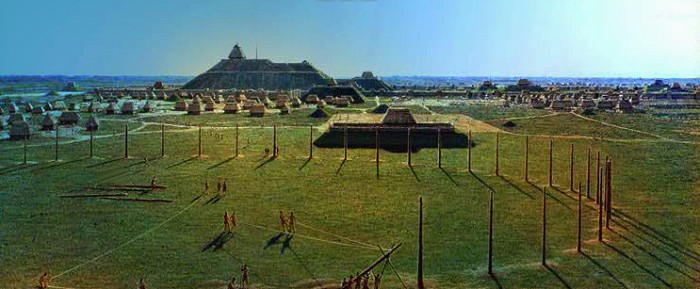“Fowler’s and others’ interpretation of these mounds became the model that everybody across the east was looking at in terms of understanding status and gender roles and symbolism among Native American groups in this time.” – Thomas Emerson, Director of ISAS.

PHOTO: Popular Archaeology
CAHOKIA MOUNDS, ILLINOIS – Archaeologists have re-examined the burial mounds at Cahokia and discovered that the previous assumptions made about Cahokian society were completely wrong.
In 1967, archaeologist Melvin Fowler was excavating at Cahokia, the largest and most influential city of the pre-Colombian Mississippian culture. The site was home to an advanced society that began a thousand years before any European came to the New World. At the site, Fowler stumbled across a massive burial site within a ridgetop mound. The mound, tagged Mound 72, was home to five mass graves. Some were filled with twenty bodies. Others held over fifty. Each of these burials were done around 1000 to 1200 AD, when Cahokia was at its peak of power.
Researchers called the find the most significant burials ever excavated in North America from this time period, and the interpretation of these burials would shape everyone’s understanding about how ancient Native Americans viewed status and gender roles from this time period of America’s history.
The main burial where all of the early interpretations came from has been called the “beaded burial”. It consists of a central pair of bodies laid on a bed of beads surrounded by other bodies. Fowler and other archaeologists believed that the bed of beads came from a ceremonial cape or blanket that had been crafted in the shape of a bird. It didn’t seem too far-fetched. The part of the pattern at the top, near the heads of the two main figures looked a lot like the head of a bird.
In Native American beliefs and traditions, birds were often representative of warriors. Because of this, Fowler believed that the two bodies belonged to two Cahokian warrior-chiefs. Because of this, everyone started to see Cahokia as a male-dominated, warrior-driven society.
Actually, No

Painting of what Cahokia would have looked like at its height, featuring the famous Cahokian “woodhenge”. [PHOTO: indiancountrytodaymedianetwork.com]
Well, it isn’t.
Researchers have recently re-opened investigation on Fowler’s excavation and analysis of Mound 72. The first thing they discovered was that there were more bodies than they originally thought. The burial actually has twelve bodies, not six, as was originally reported.
After that, researchers conducted a skeletal analysis of the two central bodies buried with the beads and discovered that only one was male. The other was, in fact, female.
“We had been checking to make sure that the individuals we were looking at matched how they had been described, and in re-examining the beaded burial, we discovered that the central burial included females. This was unexpected.” – Kristin Hedman, physical anthropologist.
Further investigation revealed that the bodies surrounding the two were actually laid out in male-female pairs. Suddenly, the theory that this was a burial of two warrior-chiefs and their servants didn’t hold water. This was a high-status burial that included women.
“Now, we realize,” Emerson said, “we don’t have a system in which males are these dominant figures and females are playing bit parts. And so, what we have at Cahokia is very much a nobility. It’s not a male nobility. It’s males and females, and their relationships are very important”.
Cahokia was not a male-dominated society as previously thought. Fowler saw warrior symbolism at Mound 72 because he was projecting what he knew about later Native American cultures onto a much earlier site. Societies that existed hundreds of years after Cahokia, in the southeast, were dominated by male warriors. Cahokia was not.
Cahokia had its own special culture at it’s height of prosperity. Researchers read about it in accounts written by the Spanish and French who met comparable societies and noted that both the males and females had rank. Cahokia’s culture was not divided by gender, it was, instead, divided by wealth, status, and rank.
The new study was written based on the work of researchers from the Illinois State Archaeological Survey at the University of Illinois and their colleagues from other institutions. All the new researchers confirm that the beaded burial at Mound 72 contains both males and females. You can read the study for yourself in the journal, American Antiquity.

